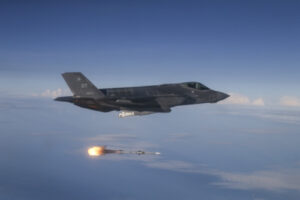Space & Missile Defense Report
-
SMDR for Mon., May 14.
- HASC Missile Defense Mark Authorizes SM-3 IB Multiyear, Pushes Boost Phase and Space Sensors
- Bridenstine Takes Reins Of NASA
- Lockheed Martin Awarded $145 Million THAAD Interceptor Contract
- House OKs Bill To Create One-Stop Shop For Commercial Space Activity
- DARPA Sees Strong Interest In Competition To Spur Rapid Space Launches
- Moon Efforts Won’t Hurt Mars Goal, NASA Head Says
-
 Uncategorized
UncategorizedHASC Missile Defense Mark Authorizes SM-3 IB Multiyear, Pushes Boost Phase and Space Sensors
The House Armed Services subcommittee on strategic forces markup of its portion of the FY ’19 defense authorization bill focused on SM-3 IB multiyear procurement, requiring the director of the […]
-
 Uncategorized
UncategorizedLockheed Martin Awarded $145 Million THAAD Interceptor Contract
The Missile Defense Agency (MDA) awarded Lockheed Martin [LMT] a $145 million modification on May 3 to produce additional Lot 10 Terminal High Altitude Area Defense (THAAD) interceptors and associated equipment. This […]
-
 Uncategorized
UncategorizedBridenstine Takes Reins Of NASA
Former U.S. Rep. Jim Bridenstine (R-Okla.) formally became NASA’s 13th administrator April 23, four days after his controversial nomination narrowly cleared the Senate. During a swearing-in ceremony at NASA headquarters in […]
-
 Uncategorized
UncategorizedHouse OKs Bill To Create One-Stop Shop For Commercial Space Activity
The U.S. House of Representatives has approved a bill that would create a “one-stop shop” in the Commerce Department’s Office of Space Commerce to authorize private-sector space activity, including exploration […]
-
 Uncategorized
UncategorizedDARPA Sees Strong Interest In Competition To Spur Rapid Space Launches
More than 20 teams have indicated they might participate in the Defense Advanced Research Project Agency’s (DARPA’s) Launch Challenge, a competition designed to promote rapid access to space for the […]
-
 Uncategorized
UncategorizedMoon Efforts Won’t Hurt Mars Goal, NASA Head Says
The Trump administration’s new push to return humans to the Moon will not come at the expense of efforts to send American astronauts to Mars, according to NASA’s new leader. […]
-
SMDR for Mon., April 23.
- MDA Tests THAAD And Patriot Interoperability
- Senate OKs Rep. Bridenstine To Lead NASA
- Greaves Sees F-35 Helping Missile Defense, Hypersonic Threat Coming From Iran And North Korea
- DoD’s Griffin Eyes Using Directed Energy For Space-Based Missile Defense
- White House Finalizing New Policy On Space Traffic Management
- Air Force To Launch Communications Relay Satellite
-
 Uncategorized
UncategorizedMDA Tests THAAD And Patriot Interoperability
The Missile Defense Agency (MDA) and Army jointly successfully tested a missile defense tracking exercise the week of April 1 to demonstrate the interoperability between the Terminal High Altitude Area […]
-
 Uncategorized
UncategorizedGreaves Sees F-35 Helping Missile Defense, Hypersonic Threat Coming From Iran And North Korea
The director of the Missile Defense Agency (MDA) told Congress the week of April 8 that he sees F-35 aircraft helping aid missile defense activities in the six to seven-year […]
